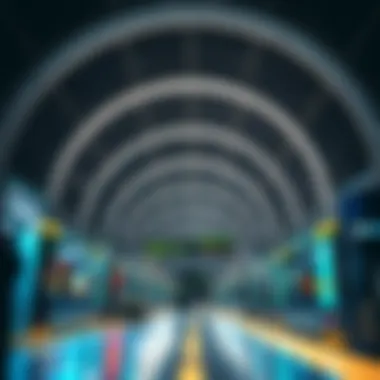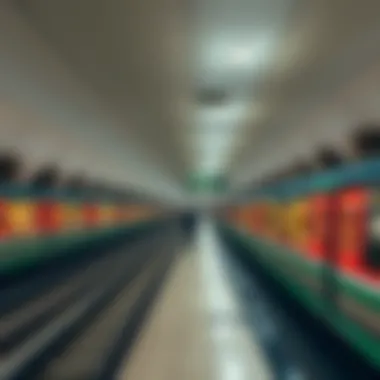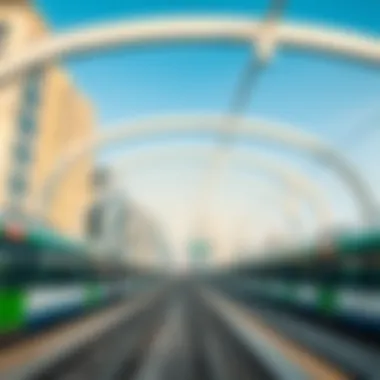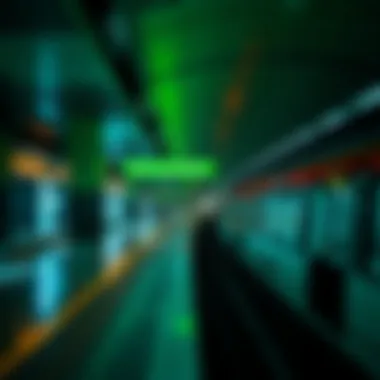In-Depth Analysis of Dubai's Green Line Metro Stations


Intro
The Green Line of Dubai Metro stands as a vital artery, linking various parts of the city while facilitating the flow of residents and visitors alike. This extensive overview aims to delve into the nuances of the Green Line stations, offering a granular perspective that is particularly relevant for investors, real estate agents, and other stakeholders. With an intricate web of stations peppered through key areas, from bustling business districts to residential hubs, understanding the dynamics around these locations is crucial for making informed property decisions.
As this article unfolds, the reader will find a thorough examination of each station's significance, how proximity to these points affects property values, and the broader implications for the real estate market in Dubai. By bridging the metro accessibility with the unique property opportunities that lie ahead, stakeholders can harness this knowledge to navigate the evolving landscape of Dubai's real estate sector.
Market Insights
Understanding the current trends in the Dubai real estate market is integral to unearthing investment potential, particularly in areas adjacent to the Green Line stations.
Current Trends in Dubai Real Estate
Diving into the present state of Dubai's real estate, it’s apparent that there has been a shift towards more sustainable and accessible developments. Properties close to the Green Line metro stations, like those near the Al Rigga or Deira City Centre stations, are increasingly sought after. Investors are placing their bets on accessibility, with studies suggesting that properties within a 500-meter radius of metro stations tend to experience a spike in value. Moreover, demographics are also shifting—young professionals and expatriates are increasingly prioritizing convenience over square footage, driving demand for smaller, strategically located living spaces.
Key Factors Influencing Property Prices
Several significant factors come into play when it comes to property pricing around these metro stations:
- Proximity to Metro Stations: As highlighted earlier, properties near metro stations see enhanced value due to improved accessibility.
- Amenities and Services: Areas close to Green Line stations tend to have a proliferation of amenities, such as supermarkets, schools, and healthcare facilities, which bolster their attractiveness.
- Urban Development: Ongoing urban development projects, especially those boosting transport network coherence, can lead to rising property values.
- Market Activity: Active engagement from local and international investors also plays a considerable role. The buzz created around these stations, especially during events and expos, can significantly alter market dynamics.
"Investors keen on the pulse of the Dubai real estate market must keep a close eye on metro accessibility as a key indicator of future property trends."
Investment Opportunities
When considering locations for property investment along the Green Line, it’s critical to pinpoint the best areas that align with both current market trends and future growth potential.
Best Areas for Property Investment
Some of the standout areas for potential investment near the Green Line include:
- Al Qusais: A hub for family residences, it's both affordable and conveniently connected to the metro.
- Al Jafiliya: Not just residential, this area is slowly transforming into a commercial blend while benefiting from metro access.
- Dubai Healthcare City: Investing in this medical hub offers not just rental potential from nearby healthcare professionals, but also long-term growth as the healthcare sector expands.
Legal Considerations for Foreign Investors
Understanding the legal landscape is essential for any investor looking to dip their toes in Dubai's property waters. For foreigners, there are some key points to keep in mind:
- Ownership Laws: Depending on the district, some areas permit 100% foreign ownership, while others might have particular restrictions.
- Visa Regulations: Property ownership can often provide pathways to residence visas, making it attractive for expatriates.
- Documentation: Ensure familiarity with the necessary legal documents required for property acquisition, such as titles and estate plans.
The intersection of metro convenience and real estate investment is what sets the stage for the future of property in Dubai. By analyzing the nuances of the Green Line stations, seasoned investors and newcomers alike can glean critical insights essential for capitalizing on emerging opportunities.
Intro to Dubai's Metro System
Dubai’s rapid urban transformations have made its metro system a cornerstone of city mobility. The metro is not just a means of transportation but a vital cog in the grand machinery of urban development. With an impressive network that spans the city, metro stations foster connectivity, reduce reliance on personal vehicles, and promote sustainable living practices. This overview focuses on the vital role that Dubai's metro system plays, particularly emphasizing the Green Line's offerings.
Historical Context


The inception of the Dubai Metro dates back to the early 2000s, spearheaded by the Roads and Transport Authority (RTA). It was envisioned to alleviate the city's infamous traffic snarls brought on by a surge in population and economic expansion. The first phase, which included the Red Line, was inaugurated in 2009, marking the beginning of a new era in public transportation for Dubai.
The Green Line, launched subsequently in 2011, was built in response to growing demand for efficient transit systems, especially in densely populated areas. It connects key residential and commercial hubs, enabling commuters to navigate the city without a hitch. This historical backdrop provides crucial insight into the planning and execution of public transport initiatives in one of the world's fastest-growing cities.
The Role of Public Transport in Urban Development
Public transport is a linchpin in the strategic planning of urban environments. In Dubai, the metro serves multiple purposes: it significantly enhances access to business centers, reduces road congestion, and promotes eco-friendly commuting practices. The government has positioned the metro not just as a transit solution but also as a key development catalyst.
- Economic Growth: The accessibility provided by metro stations has stimulated local economies, fostering commercial activity near stations.
- Sustainability Initiatives: By encouraging people to opt for public transport over cars, the metro aligns with Dubai's sustainability goals, contributing to reduced carbon emissions.
- Urban Density: With metro stations acting as focal points for urban development, there's a natural clustering of residential and commercial properties, which aids in maximizing land use efficiency.
As the metro continues to adapt and expand, it’s clear that its role will only grow, influencing the future of real estate and urban planning in this vibrant city.
"Public transport is more than just a way to get from point A to point B; it shapes our urban landscapes and defines the quality of life for residents."
In essence, understanding the historical context and the implications for urban development is crucial for investors, agents, and anyone interested in maximizing the benefits offered by the metro system in Dubai. The insights gathered here will pave the way for deeper analysis and help stakeholders make informed decisions with an eye toward the Green Line's potential.
Overview of the Green Line
The Green Line of the Dubai Metro holds significant relevance for both the city's transportation framework and the broader real estate landscape. This line, operational since 2011, serves as a crucial artery connecting various neighborhoods and districts in Dubai. By facilitating easy transit from one part of the city to another, the Green Line not only enhances accessibility for commuters but also augments property values in the vicinity of its stations. Furthermore, it integrates with other transportation modes, fortifying the concept of a comprehensive public transport system.
Operational Details
The operational intricacies of the Green Line are noteworthy. Stretching from the Al Ghubbah station in the north to the Dubai Creek station in the south, it covers around 22 kilometers and encompasses 18 stations. This expanse allows for seamless travel across diverse urban settings.
The trains on the Green Line boast state-of-the-art technology, ensuring efficient and punctual service. They operate at a frequency of about 6 to 8 minutes, depending on the time of day, which is essential for commuters with time-sensitive schedules. Notably, the line is equipped with features like air-conditioning for comfort during the sweltering summer months. Furthermore, the integration of ticketing systems with smart cards simplifies fare payment processes, enhancing user convenience.
In addition, the Green Line runs partially on elevated tracks, providing commuters with an impressive aerial view of Dubai's urban beauty. This operational design not only makes commuting an aesthetically pleasing experience but also minimizes disruptions to ground-level traffic, encouraging free flow around commercial and residential areas.
Geographical Coverage
Geographically, the Green Line carves through some of the city's most vibrant districts, including Deira and Bur Dubai. This coverage is pivotal for connecting residents to essential services such as shopping centers, health clinics, and educational institutes. For real estate stakeholders, understanding the geographical reach of the Green Line is paramount.
Areas near the stations often witness an uptick in property demand. Residents are attracted to the convenience of public transport, making locations like Al Rigga and Al Jafiliya increasingly desirable. The proximity to these stations can significantly influence the market dynamics of the surrounding properties.
"Accessibility is not just a convenience; it is a catalyst for economic growth, influencing real estate demand and urban development."
Investors looking to capitalize on the burgeoning property market in Dubai should factor in the Green Line stations when evaluating options. Properties near these stations tend to hold promise for higher rental yields and potential appreciation in value. As urban planners envisage further growth, the importance of synchronized transport networks in promoting sustainable development continues to underscore the significance of the Green Line within Dubai’s broader urban landscape.
List of Green Line Metro Stations
Understanding the Green Line metro stations goes beyond a mere list of stops. Each station serves as a hub of activity, a linchpin connecting various parts of the city, and contributing to the urban tapestry of Dubai. They are integral to public transport and reshape the real estate landscape. The Green Line provides access to landmarks, business districts, and residential areas, making it essential for potential residents and investors alike.
These stations won’t just ferry passengers; they expand opportunities. They enhance accessibility to neighborhoods that may have previously been off the radar for many. As such, knowing the stations and their characteristics is paramount for making informed decisions about property investments.
Stage One: Starting and End Stations
The Green Line kicks off with a vibrant choice of starting and end stations, notably the Etisalat station at one end and Dubai Creek at the other. Each offers distinct advantages and attributes.


- Etisalat Station: Situated close to Al Nahda and residential areas like Muhaisnah, this station is a goldmine for commuters who prioritize connectivity. From here, one can easily transfer to other metro lines, enhancing travel efficiency. The surrounding areas are ripe with amenities, including schools, restaurants, and cafes which contribute positively to property appeal.
- Dubai Creek Station: This end of the line opens up possibilities for scenic waterways and cultural experiences. It serves the historic district and offers access to the vicinity of Dubai Creek, making it appealing not just for homebuyers but also for corporate investors looking at hospitality ventures. The real estate near this station is expected to appreciate, riding the wave of tourism and local interest.
Intermediate Stations and Their Significance
Stretching across the city, the intermediate stations along the Green Line access essential neighborhoods, contributing notably to local property dynamics.
- Al Ghusais Station and Al Qusais Station are pivotal. They both provide access to burgeoning suburbs and commercial centers. Properties near these stations are witnessing a gradual increase in demand, attributed to their appealing accessibility to major highways and public amenities.
- Baniyas Square Station holds its unique charm, as it opens up to the bustling market areas. Retail opportunities flourish here, making it attractive for small business enterprises and commercial real estate investments. By being near an active market, residential properties attract professionals who crave proximity to nightlife and culture.
In sum, each station acts like a stepping stone, bolstering local economies while shaping demographic shifts in the neighborhood, and influencing overall living costs.
Comparative Analysis with Other Metro Lines
In assessing the Green Line against its counterparts, one quickly realizes its unique stature within Dubai's metro network. While the Red Line predominantly runs through highly commercialized districts, the Green Line presents a different narrative, weaving through local neighborhoods and older districts like Deira and Bur Dubai.
- The Red Line serves as the commercial backbone of the city, providing direct access to tourist hotspots and business districts. However, its stations are often set in bustling areas already saturated with high real estate values. In contrast, the Green Line prioritizes accessibility to suburban areas, where property prices are generally lower yet on a steady rise.
- This divergence reflects in property investment strategies. Investors might find greater long-term value with the Green Line. The less developed areas near these stations are prime candidates for economic uplifting, directly linking metro accessibility to increased property values.
In summary, the Green Line serves a dual purpose: it not only facilitates the day-to-day commuting needs of residents but also plays a significant role in the economic uplift of the surrounding areas, a crucial consideration for anyone looking to invest in Dubai's real estate scene.
Impact on Local Real Estate Markets
The Green Line of Dubai's Metro is not just a means of getting from point A to point B; it serves as a pivotal force in the local real estate landscape. With increasing urbanization, the need for efficient public transport has never been more pressing. As we explore the nuances of this connection, investors, agents, buyers, and sellers can glean insights that may significantly influence their real estate decisions.
Property Values and Accessibility
Access to public transportation considerably affects property values. In areas with metro stations, properties typically see an increase in demand due to enhanced accessibility. For instance, consider the vicinity of the Al Nahda station; homes in that area often command higher prices compared to those situated farther away from public transport routes.
- Key Factors
- Close proximity to metro stations can reduce commute times drastically.
- Areas with better transport links are favored, increasing rental yields.
- New developments tend to cluster around existing metro lines, further driving value.
In addition to valuing properties, accessibility can foster a diverse community. Prospective buyers often look for convenient transport options for commuting to work or school. Places like Al Jafiliya and Baniyas Square exemplify how lifestyle choices are becoming intertwined with metro station locations, transforming these neighborhoods into desirable hubs.
"Accessibility via public transport plays a critical role in shaping real estate trends. Areas near metro lines often enjoy a degree of prestige and higher valuation."
Effect on Commercial Real Estate Developments
The Green Line has a notable effect on commercial real estate developments as well. With many businesses strategically opening their doors near metro stations, commercial spaces become hot commodities. Stations like Burjuman and Deira City Centre provide a high volume of foot traffic, making them attractive locations for retail and dining establishments. This location strategy brings several advantages:
- Increased Visibility: Businesses near metro stations gain more exposure to potential customers.
- Higher Footfall: Consistent commuter traffic leads to better performance for retail outlets.
- Streamlined Accessibility: Commercial tenants favor spaces easily reached via public transportation to accommodate clients and staff alike.
Investors looking at commercial properties should keep an eye on trends around the Green Line stations. Areas experiencing redevelopment often benefit from rising prices and increased rental income. The association of metro accessibility with high-quality commercial real estate can yield a favorable return on investment.
Future Developments Related to the Green Line
The future of the Green Line Metro is a subject of much anticipation among investors and stakeholders within Dubai’s real estate market. Understanding upcoming developments provides valuable insight into how metro accessibility directly correlates with property values and residential choices. The potential for expansions and enhancements presents various benefits, shaping how communities will evolve around these transportation nodes.
Proposed Extensions and Enhancement Projects


Enhancements to the Green Line are not merely technical upgrades; they signify broader urban development strategies aimed at expanding the reach of Dubai's public transport system. The proposed extensions aim to connect underserved neighborhoods with the city’s busy commercial areas, thereby improving accessibility.
- Extended Reach: Plans outline routes extending towards the Al Quoz area, linking industrial lands with potential residential zones. This shift might entice developers to explore zoning opportunities that were previously off the table due to limited accessibility.
- Increased Frequency: The introduction of frequency enhancements will likely occur as demand rises. As metro ridership grows, reducing waiting times will undoubtedly contribute to higher satisfaction among commuters, impacting residential decisions positively.
- Interconnectivity with Other Lines: Integrating the Green Line with upcoming metro expansions, like the purple line, stands to benefit areas that are further away today. This interconnectivity encourages habitation in suburban zones, offering homebuyers new options while reinforcing existing developments.
Technological Advancements in Metro Services
As the world evolves technologically, so does the expectation for modern public transport systems. The Dubai Metro, including the Green Line, embraces innovation to streamline operations and enhance the passenger experience.
- Smart Ticketing Solutions: Initiatives such as contactless payment options and mobile ticketing are under consideration. Such systems can not only ease the operational flow but also attract a tech-savvy demographic who appreciates convenience.
- Real-Time Information Systems: Implementing advanced surveillance and real-time tracking of trains can enhance safety and punctuality. Riders having access to live updates through mobile applications keeps them informed, heightening their commuting experience and avoiding potential delays.
- Sustainability Initiatives: With Dubai's commitment to sustainability, future upgrades are likely to focus on energy-efficient solutions. Implementing green technologies to power facilities and cars can position the Green Line as a leader in eco-friendly transport.
Community and Lifestyle Considerations
When assessing the Green Line Metro stations in Dubai, one must consider not just the mechanics of transport but the larger lifestyle implications these stations offer to the communities they serve. The strategic placement of these metro stations creates not only transit hubs but also vibrant social landscapes where people live, work, and interact. Accessibility can considerably shape the day-to-day experiences of residents and influence their choices regarding where to settle.
Prospective Residents: Demographics and Preferences
Understanding who is moving into the areas surrounding the Green Line stations provides insight into current and future residential dynamics. Notably, the demographics are a colorful tapestry, ranging from young professionals to families and retirees. Each group carries distinct preferences which in turn drive demand for nearby housing.
- Young Professionals: They often prefer stations with quick access to Dubai's bustling business hubs. Living near the Al Jafiliya or Al Ghubaiba stations caters to their need for both convenience and social interaction, often favoring apartments or shared housing with vibrant nightlife options.
- Families: For those with children, proximity to schools and parks becomes paramount. Stations like Al Maktoum and Al Satwa stand out, offering a balanced mix of residential spaces and family-friendly amenities, such as playgrounds and educational institutions.
- Retirees: Older residents may seek quiet and tranquil areas with access to healthcare facilities. Stations like Dubai Health Care City station cater to these preferences, ensuring a more laid-back lifestyle while still keeping them connected to the larger city.
In essence, the demographic shifts and their preferences drive the diverse real estate offerings near the Green Line, creating a blend of bustling and peaceful neighborhoods tailored to various lifestyle choices.
Social Amenities and Their Proximity to Stations
The proximity of social amenities to metro stations is another crucial aspect of community life. When amenities are within a stone's throw, they significantly enhance the quality of life. Residents benefit from easy access to various facilities, which makes living in these neighborhoods appealing.
Some critical amenities include:
- Shopping Centers: Stations like Dubai Mall and Burjuman offer thriving retail environments, making grocery runs and shopping sprees manageable.
- Parks and Recreational Areas: Al Ghusais and Qusais stations lie near parks that provide offbeat greenspaces, crucial for runners, families, and anyone in need of a breather.
- Health Services: Access to healthcare businesses near stations, such as in Dubai Health Care City, make healthcare far more accessible for residents.
- Dining and Nightlife: Areas surrounding stations like Burjuman thrive with cafes, restaurants, and nightlife options, creating hotspots for socializing and entertainment.
"Accessibility to public amenities fosters a sense of community, allowing residents to build connections that enhance their quality of life."
Ending
In wrapping up our discussion on the Green Line Metro stations in Dubai, it’s essential to reflect on the intricate relationship between metro accessibility and urban development. As cities evolve, the foresight in connecting public transport with strategic locations is paramount. The Green Line not only facilitates movement but serves as a catalyst for growth—both residential and commercial. Its influence can be seen in the increasing property values in areas adjacent to the stations, reshaping neighborhoods and enhancing community interactions.
Recapitulating the Importance of Accessibility
Accessibility stands out as a cornerstone of urban living. The Green Line makes various neighborhoods more reachable and, in turn, promotes a vibrant urban lifestyle. This enhanced access does wonders for the social fabric of Dubai. For many residents and potential buyers, being near a metro station is akin to winning the lottery; it opens doors to employment, education, and social opportunities without the hassle of traffic or parking woes.
- Key Benefits of Accessibility Include:
- Easier Commutes: Less time spent in traffic translates to more time for personal pursuits.
- Increased Property Values: Properties near public transport,especially metro stations, typically see a steady appreciation over time.
- Enhanced Quality of Life: Seamless access to amenities improves overall living conditions for residents.
Even beyond mere practicality, accessibility fosters a sense of connectedness among communities. It allows people from various backgrounds and professions to intermingle, enriching the cultural landscape of the city.
Final Thoughts on Investment Opportunities
Investing in real estate near the Green Line metro stations is, without a doubt, a savvy choice for discerning investors. The ongoing trend of increasing demand for properties near public transport means that such locations are becoming more valuable. Investors should pay close attention not only to the immediate effects of the metro’s presence but also to the long-term implications for property appreciation and rental yields.
When considering where to put down roots or which investment to pursue, think about the following factors:
- Market Trends: Keep an eye on developments in nearby areas that may affect property values.
- Property Availability: Look for diverse property types, from luxury apartments to affordable housing, to cater to various demographics.
- Community Developments: New commercial projects or social amenities that arise from metro expansions can significantly boost property desirability.















